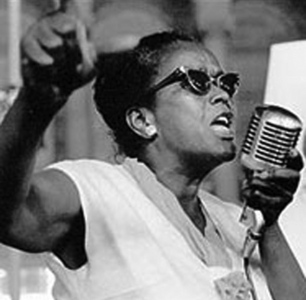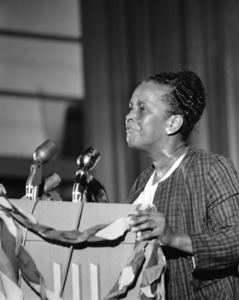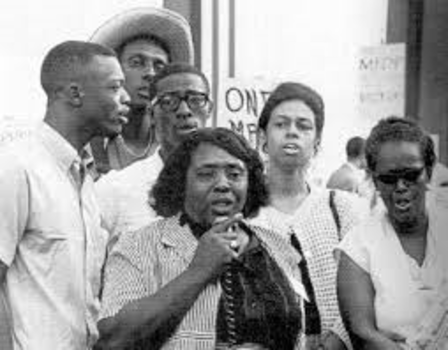Occidental College Csp 57 Liberal Arts at the Brink


In 1964, at the height of the civil rights motion, the bully organizer Ella Baker said: "Until the killing of black men, black mothers' sons, becomes as important to the rest of the country as the killing of a white mother's sons, nosotros who believe in liberty cannot balance." Bernice Johnson Reagon subsequently wrote "Ella'due south Song" based on those words, made famous by the a cappella group, Sugariness Beloved in the Rock.
Baker's words certainly resonate today, as nosotros witness the rebirth of a new civil rights movement, sparked by the police killings of immature black men, just rooted in the underlying grievances of racial injustice around jobs, housing, schools, and the criminal justice system. As the protests spread from Ferguson to Los Angeles, New York, Cleveland and effectually the country, today'south young activists can larn much from Ella Baker'due south ideas. Working behind the scenes, she helped transform the Southern sit-in protests into a powerful movement for racial justice, led by young people with lots of anger and determination, only little political experience.
Tardily in the afternoon of February ane, 1960, 4 young blackness men -- Ezell Blair Jr., David Richmond, Franklin McCain, and Joseph McNeil, all students at Due north Carolina Agricultural and Technical College in Greensboro -- visited the local Woolworth'south shop. They purchased schoolhouse supplies and toothpaste, and then they sat downwardly at the shop'due south lunch counter and ordered coffee. "I'm sorry," said the waitress. "We don't serve Negroes here."
The four students refused to give up their seats until the shop airtight. The local media presently arrived and reported the sit-in on television set and in the newspapers. The 4 students returned the next day with more than students, and past Feb 5 nearly 300 students had joined the protestation, generating more than media attention. Their action inspired students at other colleges across the South to follow their instance. Past the end of March sit-ins had spread to 55 cities in 13 states. Many students, by and large blackness but also white, were arrested for trespassing, disorderly conduct, or disturbing the peace.
Over Easter weekend, Apr 16 to 18, many of those students came to Baker'due south alma mater, Shaw University, a black college in Raleigh, Northward Carolina, to discuss how to capitalize on the growing momentum of the sit down-ins. The fruit of the meeting was the Student Nonviolent Analogous Committee (SNCC), an organization to interpret these local deportment into a wider movement. SNCC would aggrandize the sit down-in campaign, but it also used other tactics, such every bit freedom rides and voter registration drives, to tear down segregation. SNCC's work reinvigorated the civil rights movement.
Many accounts report that the Greensboro protestation "sparked" or "catalyzed" the sit-in movement that led to SNCC'south founding. Only in the middle of all this was Ella Baker, a 57-twelvemonth-old veteran organizer. She had spent decades traveling throughout the S for the National Association for the Advancement of Colored People (NAACP) and the Southern Christian Leadership Briefing (SCLC). Long earlier there were Rolodexes, e-mail, and Facebook, she was famous for her vast social network of contacts. She gently encouraged the young activists to build a move from these isolated local protests. It is no accident that SNCC's founding convention took identify at Baker's alma mater.
Many of the young civil rights activists called her "Fundi," a Swahili title for a primary technician who oversees apprentices, to acknowledge Baker's office as their mentor. She eschewed a visible function, concentrating on patiently training the adjacent generation of social change leaders. She spent more than than fifty years every bit an organizer merely was less well-known than many of those she trained and nurtured with the NAACP, SCLC, SNCC, and other organizations.
Born in 1903, Baker grew up in rural N Carolina not far from where her grandparents had been slaves. Every bit a girl, Bakery listened to her grandmother tell stories virtually slave revolts. Her mother, a former instructor and deeply religious, tutored Ella at dwelling and coached her in public speaking. Equally a child, Ella was role of a supportive and tightly knit black community, where friends, relatives, and neighbors helped each other out. Her grandfather mortgaged the family subcontract to help feed families in need. For high school, Baker'due south parents sent her to the boarding school affiliated with Shaw Academy. She remained at Shaw for higher, edited the student newspaper, and graduated every bit class valedictorian in 1927.
And then she moved to Harlem. Financial hardship forced Baker to gear up aside her dream of getting a graduate caste in sociology. Despite her higher teaching, her race and gender limited her chore prospects, and she wound up waiting on tables and working in a manufacturing plant. She began to write articles for the American West Indian News and in 1932 found a job equally an editorial assistant and office manager for the Negro National News.
The suffering brought on by the Low troubled her deeply. Harlem was a hotbed of radical activism, and Bakery soon got involved in local groups working on behalf of tenants and consumers. In 1931 she organized the Young Negroes' Cooperative League and became its national director. The group sponsored cooperative ownership clubs and grocery stores both to reduce prices and to bring people together for commonage activity. In her next job, paid for past the New Deal's Works Progress Administration, she organized consumer cooperatives amid housing project residents. She taught adult literacy and consumer education, oft with a focus on young women and housewives. In 1935 she wrote an exposé of the exploitation of blackness domestic servants for the NAACP journal Crunch.
Bakery started working for the NAACP in 1938 and three years later became its assistant field secretary. For five years, she traveled throughout the South, recruiting new members, working with local leaders to strengthen their chapters, and helping them organize campaigns against lynching, for equal pay for blackness teachers, and for job training. I of the leadership-training workshops she organized was attended by Rosa Parks, an active NAACP member in Montgomery, Alabama.
Baker understood that local activists in the Due south always risked facing financial and physical threats for their involvement with the ceremonious rights organization. Baker's speech at the NAACP'southward annual conference in 1942 outlined her focus on identifying concrete, winnable local issues that could build the organization:
What are the things taking place in our community which we should similar to see changed? Have that one matter--getting a new school building; registering people to vote; getting bus transportation--take that i affair and work on it and become it done.
At the time, the NAACP's leadership was dominated by middle-class blackness businessmen, male person professionals, and ministers, but near of its grassroots activists were working-grade women and men. Baker's experiences convinced her that "strong people don't need stiff leaders." She worked to cultivate what she called "group leadership" in contrast to leadership by charismatic figures or by people of higher economic status. She would carry these lessons with her the rest of her life.
In 1946 Baker left her NAACP job and returned to New York Urban center to raise her niece. While working every bit the Harlem manager of the American Cancer Society, she volunteered with the NAACP'south New York City chapter, organizing protests enervating school desegregation. In 1952 she was the start woman elected chapter president. In 1951 and 1953 she ran for the New York City Council as a fellow member of the Liberal Political party, losing both times. It was the merely time she allowed the spotlight to shine on her.

Fannie Lou Hamer singing at MFDP boardwalk rally in Atlantic City in 1964. From left -- Emory Harris, Stokely Carmichael (in hat), Sam Cake, Eleanor Holmes, and Ella Bakery.
Soon afterwards the 1955 Montgomery charabanc boycott erupted, Baker, Bayard Rustin, and Stanley Levinson (a close adviser to Martin Luther King Jr.) used their connections with northern liberals and unions to plant In Friendship, which raised funds and provided support for the boycott entrada. At the end of 1956, the Supreme Court ruled that Montgomery's segregated charabanc system was unlawful. The victory could have remained a local triumph rather than a national bellwether. Rustin, however, laid out the thought for edifice what he called a "mass motion across the South" with "disciplined groups prepared to human activity as 'nonviolent shock troops.'" Rustin, Levinson and Bakery talked extensively with King well-nigh establishing a new organization to build similar campaigns throughout the Southward. This was the genesis of the Southern Christian Leadership Briefing (SCLC), which catapulted Male monarch from local to national leadership. Rustin convinced Baker to run the new organization. The initial program was for her to spend six weeks based in Atlanta, but information technology turned into a two-and-a-one-half-yr stint.
During this time she had many titles, but she was never given the title of director, which was reserved for a male minister. Baker bristled at the sexism and outsize egos of the ministers who ran SCLC, including King. Despite her long experience as a successful grassroots organizer, they treated her as if she were the hired help. Moreover, King and his fellow ministers lacked the time and feel to build a grassroots organisation. SCLC drew on the reputations of its ministers to draw attention to racial injustice and to assist sponsor voter registration drives, but information technology never became a mass-membership organization.
Baker was on the brink of resigning from SCLC when the pupil demonstration movement began in early on 1960. Bakery wrote, and she and Rex cosigned, the invitation letter to SNCC'south founding coming together.
Bakery took responsibility for organizing the event. The SCLC leaders figured that they could recruit its leaders into forming a youth co-operative of the organization, but Baker counseled the immature activists to shape their ain organization. She expected 100 participants to attend, but more than 300 activists showed up. These included black students from 56 colleges and loftier schools across the South, a handful of white southern students, and students from northern and midwestern colleges (including representatives of Students for a Democratic Social club) who had been organizing pickets at Woolworth'due south stores to bear witness support for the sit-ins.
Baker made sure that students were well represented among the speakers. She enlisted as cardinal speaker James Lawson, a theology pupil at Vanderbilt Academy who had organized workshops on nonviolence for students in Nashville, Tennessee, and had helped lead the sit-ins in that metropolis.
In her closing speech, "More than Than a Hamburger," Baker pushed the students to dream of how their lunch-counter sit down-ins could develop into larger efforts to challenge racism in "every aspect of life." She emphasized the importance of growing grassroots group leadership rather than relying on the charisma of whatsoever individual, a not-as well-subtle dig at King and his fellow ministers. The SCLC ministers asked Baker to convince the students to become part of their arrangement. Baker refused, but with her approval, the students voted to course their own arrangement, SNCC.
SNCC might take apace disintegrated had Baker not nurtured it and helped the students learn to run the system on their own. She resigned from SCLC and worked as a volunteer for SNCC, supporting herself as a paid consultant for the Atlanta YMCA. She recruited Jane Stembridge, a white Virginian who was a student at Union Theological Seminary in New York, to run the Atlanta office. With Baker's back up, Bob Moses, a blackness math teacher from New York who traveled to Atlanta to volunteer for SCLC'due south voter registration drive, soon defected to SNCC.
The volunteer staff put out a newsletter, Educatee Voice, that helped give the new group an identity and helped spread the word. One of the outset checks sent to help the new arrangement came from Eleanor Roosevelt.
As Baker guided SNCC's young activists, she reminded them of her belief in radical democracy: "People did non really need to be led; they needed to be given the skills, information, and opportunity to lead themselves." Every bit students took on more than leadership responsibility and worked on the liberty rides and voter registration, they put her ideas into do and connected to ask Bakery for advice. Those attention SNCC's marathon meetings recall that Baker, who by that time had thirty years of experience in movement building, would sit silently much of the time and and so make a few comments. Reflecting on Baker's talent for listening to everybody and then summarizing what was virtually of import, former SNCC chair Charles McDew explained, "Somebody may have spoken for 8 hours, and vii hours and 53 minutes [of it] was utter bullshit, but 7 minutes was good. She taught us to glean out the seven minutes."
In 1964, Baker went to Mississippi to participate in SNCC's Liberty Summertime projection that brought over a thousand college student volunteers to the state to register black voters and aid lead "freedom schools." That summer, hundreds of volunteers were arrested; 67 churches, homes, and stores were bombed past racist thugs. 3 of the volunteers -- black Mississippian James Chaney and white radicals Andrew Goodman and Michael Schwerner -- were murdered by segregationist vigilantes. The murders, including the hunt for the bodies of the victims, drew national media attention. When Baker was asked her reaction, she said:
The unfortunate thing is that it took this... to make the rest of the country turn its eyes on the fact that there were other (black) bodies lying in the swamps of Mississippi. Until the killing of a black mother's son becomes every bit important as the killing of a white female parent's son, we who believe in freedom cannot residue.
The summer campaign culminated in a mock election organized past SNCC volunteers across the state. Black voters elected an integrated slate of 68 members, under the banner of the Mississippi Freedom Democratic Party (MFDP). Their plan was to attend the Autonomous Party's national convention in Atlantic City in August and inquire the credentials committee to recognize the MFDP. This was a direct challenge to the official all-white delegation, which brutally excluded blacks from voting.
Baker, along with John Lewis, Marion Barry, and others, began contacting Friends of SNCC and other civil rights activists around the land, asking their help enlisting Democratic Party officials, elected officials and convention delegates to support the MFDP delegation. By the start of August, they report that 9 state delegations from the Northward and West, and 25 Autonomous members of Congress, had promised to support MFDP's claim to represent the state at the convention. On August half-dozen, Bakery gave the keynote spoken communication at the MFDP's statewide convention at the Masonic Temple in Jackson, reminding them that their struggle in Atlantic Metropolis was only ane part of a broader movement. When they arrived in Atlantic City, the MFDP voiced their demands, made famous by Fannie Lou Hamer's moving testimony almost her harsh life equally a sharecropper on a Mississippi Delta cotton plantation and the retaliation inflicted on her for simply trying to annals to vote.
President Lyndon Johnson, fearful of alienating southern white voters, rejected the MFDP challenge but offered a compromise, offering them two seats in the state delegation. Led by Fannie Lou Hamer and Bob Moses, the MFDP rejected the compromise, just the controversy pressured the Democratic Political party to alter its rules for subsequent conventions to require more women and minority delegates. SNCC'due south Freedom Summer campaign had not only helped turn the nation's eyes on southern racism and the repression of civil rights activists, only also played a fundamental role in the passage of the 1964 Voting Rights Act, one of the movement'southward landmark victories.
Baker was not pleased with SNCC'southward turn toward "blackness power" in 1966 nether the leadership of Stokely Carmichael. She gradually drifted away from SNCC, but for the balance of her life, she continued to work on progressive issues. She spent several years working on school desegregation efforts with the Southern Conference Educational Fund. She too expanded her piece of work to include independence struggles in Puerto Rico and in Africa. She also allied herself with the Women's International League for Peace and Freedom and other women's rights groups. She remained an activist until her death on her 83rd birthday -- December xiii, 1986.
John Lewis, a SNCC leader and at present a Congressman from Atlanta, recalled that Baker "was much older in terms of age, just I think in terms of ideas and philosophy and delivery she was 1 of the youngest persons in the movement."
Peter Dreier is the E.P. Clapp Distinguished Professor of Politics and chair of the Urban & Environmental Policy Department at Occidental College. His nigh recent volume is The 100 Greatest Americans of the 20th Century: A Social Justice Hall of Fame (Nation Books, 2012). Ella Baker is 1 of the people profiled in the book.
Popular in the Community
fitzgeraldprabile.blogspot.com
Source: https://www.huffpost.com/entry/ella-baker-ferguson-and-b_b_6368394
0 Response to "Occidental College Csp 57 Liberal Arts at the Brink"
Post a Comment